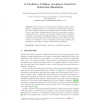Free Online Productivity Tools
i2Speak
i2Symbol
i2OCR
iTex2Img
iWeb2Print
iWeb2Shot
i2Type
iPdf2Split
iPdf2Merge
i2Bopomofo
i2Arabic
i2Style
i2Image
i2PDF
iLatex2Rtf
Sci2ools
MIG
2009
Springer
2009
Springer
A Predictive Collision Avoidance Model for Pedestrian Simulation
We present a new local method for collision avoidance that is based on collision prediction. In our model, each pedestrian predicts possible future collisions with other pedestrians and then makes an efficient move to avoid them. Experiments show that the new approach leads to considerably shorter and less curved paths, ensuring smooth avoidance behaviour and visually compelling simulations. The method reproduces emergent behaviour like lane formation that have been observed in real crowds. The technique is easy to implement and is fast, allowing the simulation in real time of crowds of thousands of pedestrians.
Collision Avoidance | Computer Graphics | MIG 2009 | Possible Future Collisions | Smooth Avoidance Behaviour |
| Added | 27 May 2010 |
| Updated | 27 May 2010 |
| Type | Conference |
| Year | 2009 |
| Where | MIG |
| Authors | Ioannis Karamouzas, Peter Heil, Pascal van Beek, Mark H. Overmars |
Comments (0)

